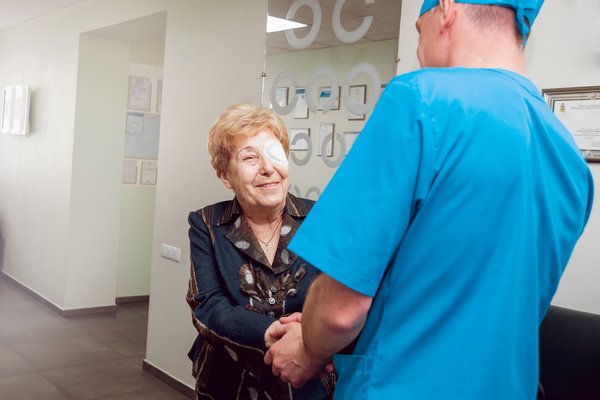Cataract surgery: what to expect
An interview with Cecilia Lollinga en Anja Boen, OK-assistenten at OMC HanzeKliniek in The Netherlands by OPHTEC, 16 February 2020“People often tell us they think it’s ‘a piece of cake’. But it is a real surgical procedure that needs to be prepared and completed properly. We recently had a patient in the operating theatre who was accompanied by his daughter. She knew him well: ‘Tell my father he’s not allowed to clean the barn tomorrow.’We, of course, gave him instructions on what to do and what not to do.”
“A lot of people feel fine the day after surgery. It’s important to realise that the wounds, small as they are, need time to close. In order to prevent infections, patients are not allowed to do any work in a dirty or dusty environment. They’re also not allowed to do heavy work or strenuous exercise, as this may put pressure on the eye and it takes longer for the wounds to close."
Diagnosis and intake
“Most people who come to us for surgery went to an optician, who was unable to help them with new prescription glasses because of suspected cataract. The optician then sends the patient to their GP for a referral to an ophthalmologist. Such a referral is necessary for insurance purposes, but GPs will almost always give a referral anyway."
“The first appointment is with the doctors, who welcome the new patients. We reserve certain slots in our agenda for cataract patients, to keep waiting times to a minimum. It is, of course, frustrating for patients to have to wait too long, and surgery also becomes more difficult if it takes a long time, because the lens may harden due to the cataract.”
“During the first appointment, the patients are examined by the TOA, the technical ophthalmological assistant, who measures the eyes and applies eye drops to widen the pupil. This enables the ophthalmologist to determine whether or not the patient actually has cataract. If they do, they are put on a waiting list and asked to fill in a questionnaire.”
“The back office checks the medical file and, if necessary, contacts medical specialists to rule out health risks. We perform surgery under local anaesthesia and sometimes our doctors need additional information from specialists about a specific patient, for instance if there are problems with their heart or lungs. Patients must be able to lie flat for half an hour.”
“The ophthalmologist who performs the procedure checks the completed questionnaire and approves the patients for surgery. They are then put on the schedule for the operating theatre. They then receive an invitation for the procedure, which takes place at another location on our premises, in the surgical centre."
The surgery
“On the day of surgery, we welcome patients with a cup of coffee. Then, eye drops are applied to widen and anaesthetise the pupil. Half an hour before the operation, they go to the room with the operating chair. There, they put on a surgical gown over their own clothes, overshoes and a surgical cap.
The chair is then rolled to another room, where the patient is put in the correct position. The anaesthetic is applied and the eye is disinfected.
When the patient is ready, they are moved to the operating theatre, under the microscope. The operating theatre has been prepared by the operating theatre assistant and the nurses. Next, the ophthalmologist and the operating theatre assistant put on sterile clothes and, after checking everything again, the surgical procedure can start.”
“The procedure usually lasts no more than thirty minutes, from entering the operating theatre to leaving it. While their eye is anaesthetised, patients do feel touches. It does not hurt, but they do feel differences in pressure in the eye during surgery. If a patient is very nervous, this can raise the pressure in the eye, which means that they create their own problem. Our task is to help patients relax as much as possible.”
“During surgery, the lens is divided into sections, which are pulverised and sucked up with a specially designed device. The capsule in which the lens is located remains intact and the artificial lens is inserted in it.”
“After the surgery, people are given eye drops to lower the pressure as well as an ointment, so that they don’t have to apply the eye drops every day. They are given an eye patch to wear on the day of surgery and during the nights for another week, to prevent them from accidentally rubbing the eye. They can take off the dressing the morning after surgery."
“They leave the operating theatre after a consultation with the doctor. They are given a follow-up letter, eye drops, lifestyle rules and information on potential adverse effects, such as burning eyes. If they suffer a lot from side effects, they must contact us; there are emergency telephone numbers in the letter. We always emphasise that they must call us if there is a problem."
After the surgery
“Back home, patients may still feel something, like they have a grain of sand in their eye. The eye may also burn a little. But two paracematol will do the job. The day after the surgery, they get a phone call, unless the ophthalmologist explicitly indicated after the surgery that they have to come to the clinic for a check-up. If patients notice any unexpected side effects, they must contact us.”
“A week after surgery, patients come back for a check-up by the optometrist, to see whether the eye is healing properly. Patients have to apply anti-inflammatory eye drops for four weeks."
“A number of weeks later, patients are given the final recommendation, and they may be prescribed modified glasses. But this depends on the degree of recovery of the eye, which in turn depends on a number of different factors. Cataract surgery never has to be repeated, as the new lens cannot cloud. It is possible that posterior capsular opacification develops in the capsule of the old lens, but this can be solved with laser treatment.”
“During the first two weeks after surgery, patients must be careful when bending over and lifting heavy objects, so as not to put pressure on the eye. They should also avoid playing certain sports, such as ball games and lifting weights. Such activities may prevent the wound from closing, which is undesirable given the risk of infection.”
“When a patient can return to work depends on the type of work, how heavy or dirty it is. Driving a car between the surgery and the first check-up one week later is advised against. During the check-up, patients are told whether they can drive again or not. We also put this on paper, which is important for insurance purposes.


